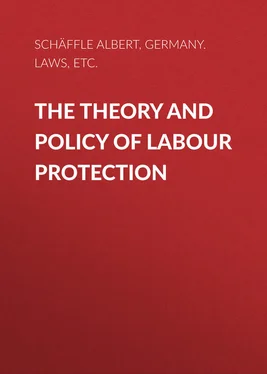Albert Schäffle - The Theory and Policy of Labour Protection
Здесь есть возможность читать онлайн «Albert Schäffle - The Theory and Policy of Labour Protection» — ознакомительный отрывок электронной книги совершенно бесплатно, а после прочтения отрывка купить полную версию. В некоторых случаях можно слушать аудио, скачать через торрент в формате fb2 и присутствует краткое содержание. Жанр: Юриспруденция, Юриспруденция, foreign_antique, foreign_prose, на английском языке. Описание произведения, (предисловие) а так же отзывы посетителей доступны на портале библиотеки ЛибКат.
- Название:The Theory and Policy of Labour Protection
- Автор:
- Жанр:
- Год:неизвестен
- ISBN:нет данных
- Рейтинг книги:5 / 5. Голосов: 1
-
Избранное:Добавить в избранное
- Отзывы:
-
Ваша оценка:
- 100
- 1
- 2
- 3
- 4
- 5
The Theory and Policy of Labour Protection: краткое содержание, описание и аннотация
Предлагаем к чтению аннотацию, описание, краткое содержание или предисловие (зависит от того, что написал сам автор книги «The Theory and Policy of Labour Protection»). Если вы не нашли необходимую информацию о книге — напишите в комментариях, мы постараемся отыскать её.
The Theory and Policy of Labour Protection — читать онлайн ознакомительный отрывок
Ниже представлен текст книги, разбитый по страницам. Система сохранения места последней прочитанной страницы, позволяет с удобством читать онлайн бесплатно книгу «The Theory and Policy of Labour Protection», без необходимости каждый раз заново искать на чём Вы остановились. Поставьте закладку, и сможете в любой момент перейти на страницу, на которой закончили чтение.
Интервал:
Закладка:
The characteristic peculiar to the three first divisions of workshops, and that which distinguishes them from the factory, although they in some respects resemble it, is that they give employment to but a very small number of workmen outside the limits of the family which maintains them.
The British Factory Acts include under the head of workshops those businesses in which no motive power is used, but in which protected persons (women, children, and young persons) are employed. Workshops of this kind are treated with varying degrees of stringency, according to whether they employ protected persons of all kinds, or only women (no children or young persons), and according to whether they are carried on in domestic workshops (dwelling-rooms) or otherwise.
Household industry, called also “home industry” in the Auer Motion is the industrial preparation and manufacture of commodities, not the production of material, nor trading, carrying, or service industry. It has therefore characteristic c (viz. that it excludes the production of raw material and the initial processes in connection therewith) in common with the factory and all workshops, as well as with that part of family industry which is not included in household industry properly so called; the very term Household Industry , in fact, indicates this.
The peculiarity of household industry (in the technical sense of the term) is that it is carried out merely at the orders and not under the supervision of the contractor. The Imperial Industrial Code, more especially the von Berlepsch Bill, in extending truck protection to household industry, understands this term to include all industrial workers engaged in the preparation of commodities under the direction of some firm or employer, but not working on the premises of their employers; and these workers may or may not be required to furnish the raw materials and accessories for their work. The home-workers carrying on this kind of preparation of commodities do so as a rule not in special work-rooms, but in their own dwelling-rooms or houses, or in little courtyards, sometimes in sheds and outhouses, sometimes even in the open air. For the rest, they may be either a few workers out of a family working on their own account, or a whole family working under the superintendence of one of its members. The most important characteristic of household industry is that it is work undertaken at the orders of a third party, therefore that it has no commercial independence, and takes no part in the sale of its products (characteristic i of factory labour); and therefore obviously we have no occasion to consider the other characteristics d , e , f , g , h , in defining household industry.
A distinction must be drawn between household industry carried on with or without the intervention of middlemen; for it takes a very different form, according to whether the arrangements between the industrial home-worker on the one side, and the giver of orders and provider of materials on the other, are made with or without the intervention of special agencies for ordering, supervising, collecting, and paying (commission agents, contractors, sweaters). The possible removal – or at least control and regulation – of the middleman forms one fundamental problem – hitherto unsolved – of labour protection in the sphere of household industry, and the protection of industrial home-workers against their parents and against each other forms another.
Family industry to a great extent practically coincides with household industry, but not necessarily or entirely so; for family industry – meaning of course the work of preparing and manufacturing commodities – may be the preparation of goods for independent sale, not for sale by a third party in a shop or warehouse, and as a matter of fact this is very largely the case. Family industry sometimes even falls under the head of workshop labour (cf. § 154 of the von Berlepsch Bill). Its distinguishing characteristic is that it employs only workers belonging to the same family, hence the exact reverse of the Factory (see characteristic a ). It includes all those industrial pursuits “in which the employer is served only by members of his own family” (Bill, § 154, par. 3).
We come now to consider the meaning of the various headings under which personal protection falls.
Juvenile Workers. Juvenile workers of both sexes have long been subject to protection, and this kind of protection is gradually spreading all over Europe, and in more and more extended proportions. We must first ascertain what is the exact meaning of the term juvenile workers as used in the labour-protective laws.
In contrast to juvenile labour stands adult labour, or more accurately adult male labour, since adult women – not of course as adults but as women – are placed more or less on the same footing as juvenile workers in the matter of protective legislation.
The distinction between adult wage-labour and juvenile wage-labour, and the subdivision of the latter into infant-labour, child-labour, and the labour of “young persons,” is not of importance in all departments of labour protection, but it is of the utmost importance in protection of employment , especially in prohibition of employment on the one hand, and restriction of employment on the other. This prohibition and restriction of juvenile employment does not apply to all industries, but only to certain branches of industry and kinds of work, and to specially dangerous occupations.
In order to determine exactly what is meant by infant-labour, child-labour, and the labour of “young persons,” we must consider the inferior limit of age below which there is a partial prohibition of employment, and the superior limit of age beyond which labour is treated as adult labour as regards protection, receiving none, or only a very limited measure of it. The inferior limit does not as yet coincide with the beginning of school duties, nor does the superior limit coincide with the attainment of majority as recognised by common law.
“Juvenile labour” – permitted but restricted – stands midway between infant-labour, altogether prohibited in some branches of industry, and adult labour, permitted and unrestricted, or only slightly restricted; and within the inferior and superior limits of age it is divided into child-labour and labour of “young persons.”
The industrial laws of northern and southern countries differ in the inferior limit of age which they assign to prohibited infant-labour, as distinguished from child-labour permitted but restricted. In Italy this limit has hitherto been fixed at the completion of the ninth year; in England and France (in textile, paper, and glass industries), in Denmark, Spain, Russia, and in most of the industrial States of the North American Union, at the completion of the tenth year; in Germany hitherto, and in France (in general factory-labour, in workshops, smelting-houses, and building-yards), in Austria, Sweden, Holland and Belgium (Act of 1889), at the completion of the twelfth year; in Germany it is fixed for the future at the completion of the thirteenth year, as it soon will be in France also, in all probability – and in Switzerland at the completion of the fourteenth year.
The proposal of Switzerland at the Berlin Conference to fix the general inferior limit of age at 14 years was not carried. It has hitherto been prevented in Germany by the fact that in Saxony and elsewhere school duties are not exacted to the full extent as late as the age of 14.
The Berlin Conference voted for fixing the limit at the completion of the twelfth year, while agreeing that the limit of 10 years might be fixed in southern countries in view of the early attainment of maturity in hot climates. The limit is fixed higher with regard to protection in certain specified dangerous or injurious occupations: for boys engaged in coal mines the limit of 14 years was laid down by the resolutions of the Berlin Conference. 7
Читать дальшеИнтервал:
Закладка:
Похожие книги на «The Theory and Policy of Labour Protection»
Представляем Вашему вниманию похожие книги на «The Theory and Policy of Labour Protection» списком для выбора. Мы отобрали схожую по названию и смыслу литературу в надежде предоставить читателям больше вариантов отыскать новые, интересные, ещё непрочитанные произведения.
Обсуждение, отзывы о книге «The Theory and Policy of Labour Protection» и просто собственные мнения читателей. Оставьте ваши комментарии, напишите, что Вы думаете о произведении, его смысле или главных героях. Укажите что конкретно понравилось, а что нет, и почему Вы так считаете.












![Edward Ellis - Adrift on the Pacific - A Boys [sic] Story of the Sea and its Perils](/books/753342/edward-ellis-adrift-on-the-pacific-a-boys-sic-s-thumb.webp)